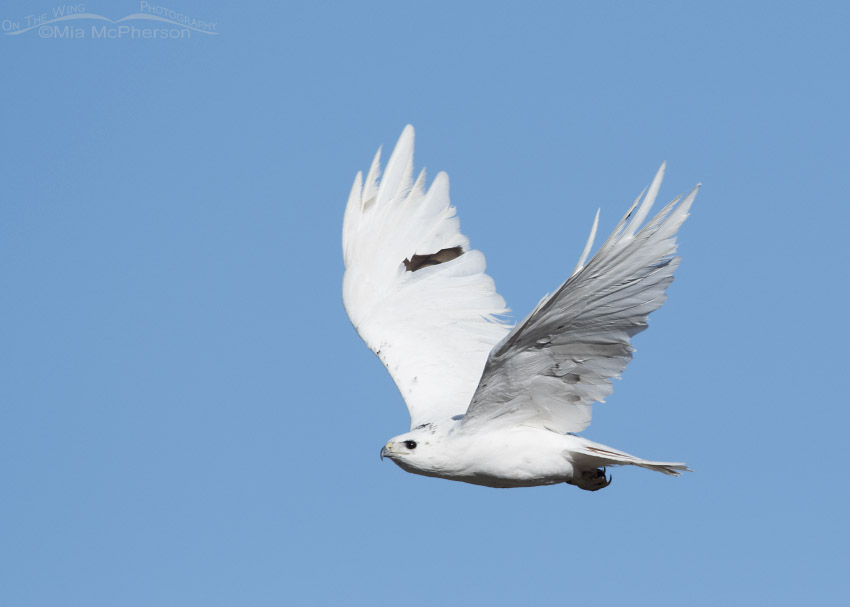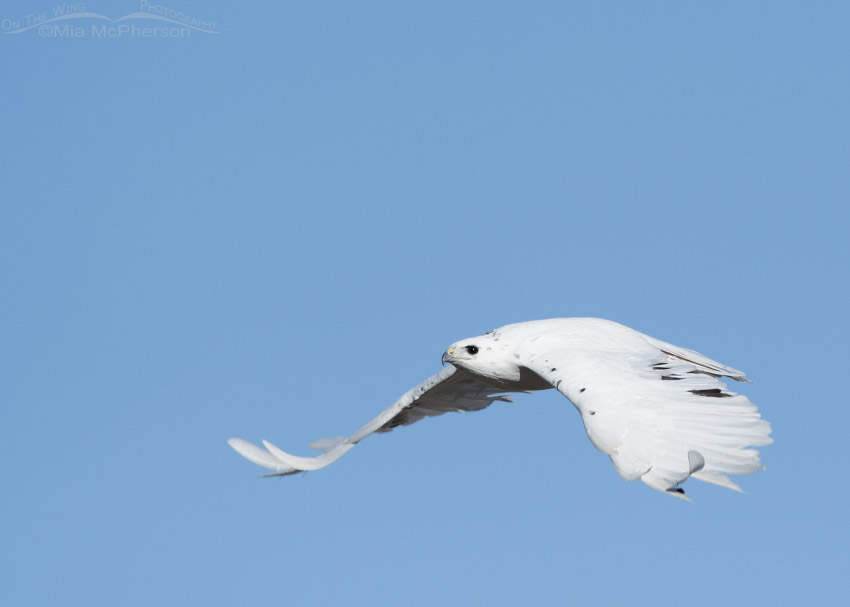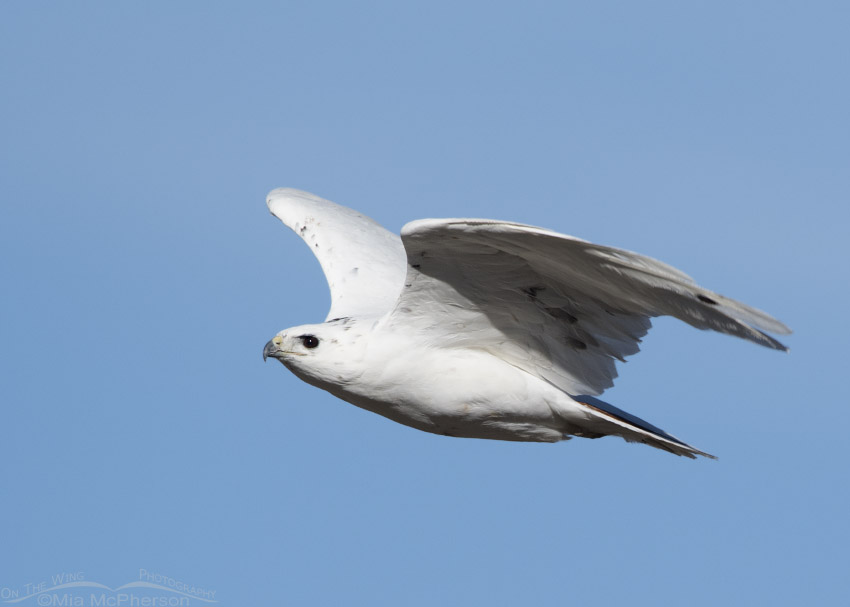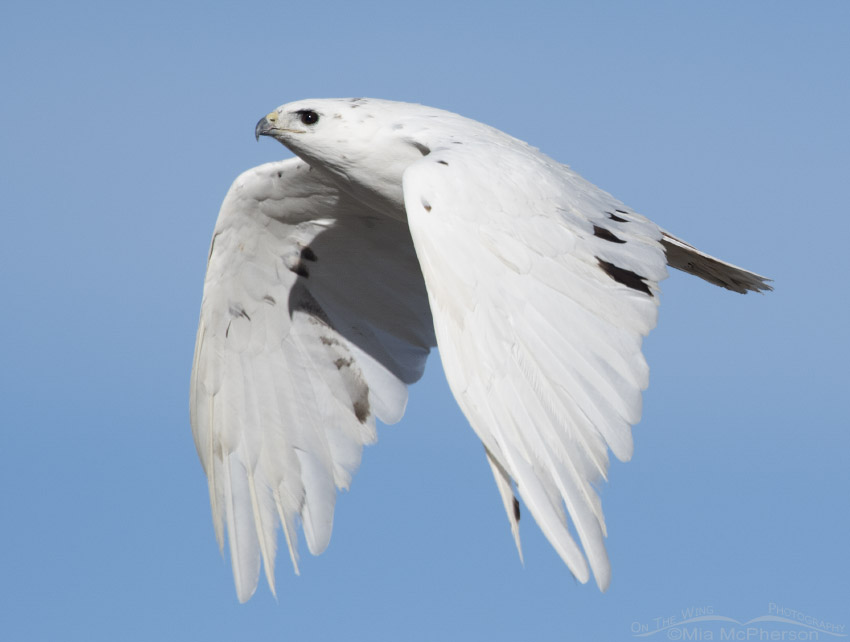 Leucistic Red-tailed Hawk adult in flight – Nikon D500, f7.1, 1/2500, ISO 400, +0.7 EV, Nikkor 500mm VR with 1.4x TC, natural light, not baited
Leucistic Red-tailed Hawk adult in flight – Nikon D500, f7.1, 1/2500, ISO 400, +0.7 EV, Nikkor 500mm VR with 1.4x TC, natural light, not baited
A friend of mine and fellow photographer, Jolie, sends me photos of birds on occasion when she needs help identifying them and a few days ago she asked for help with two raptors and I told her to send her photos on to me and that I would help.
When I opened the first image my jaw dropped and my pulse quickened. Okay, my heart raced! I was 99% sure what I was seeing was a partially leucistic Red-tailed Hawk but I asked if she had any other images of it that showed the tail and she sent one which immediately confirmed my ID because there were a few tail feathers that showed partial leucism where some the individual tail feathers were white and part showed the normal red with black terminal banding of an adult Red-tailed Hawk.
(The other raptor image Jolie sent was of a Ferruginous Hawk)
 Flying leucistic Red-tailed Hawk – Nikon D500, f7.1, 1/2500, ISO 400, +0.7 EV, Nikkor 500mm VR with 1.4x TC, natural light, not baited
Flying leucistic Red-tailed Hawk – Nikon D500, f7.1, 1/2500, ISO 400, +0.7 EV, Nikkor 500mm VR with 1.4x TC, natural light, not baited
I was certain that the hawk was not albino because of its eye color, the eyes would be pink if the hawk were albino and this bird’s eyes are dark like a normal adult Red-tailed Hawk. So what is leucism?
Definition of leucism:
an abnormal condition of reduced pigmentation affecting various animals (such as birds, mammals, and reptiles) that is marked by overall pale color or patches of reduced coloring and is caused by a genetic mutation which inhibits melanin and other pigments from being deposited in feathers, hair, or skin. The presence of unusual plumage contrasts (such as a very pale-winged bird with dark brown tail) is a strong indication of leucism. — David Allen Sibley
This Red-tailed Hawk does have a few normal colored feathers on its wings, tail, neck and head but the majority of its body is a pure snowy, white.
 Leucistic Red-tailed Hawk adult flying by – Nikon D500, f7.1, 1/2500, ISO 400, +0.7 EV, Nikkor 500mm VR with 1.4x TC, natural light, not baited
Leucistic Red-tailed Hawk adult flying by – Nikon D500, f7.1, 1/2500, ISO 400, +0.7 EV, Nikkor 500mm VR with 1.4x TC, natural light, not baited
When I first saw the hawk myself it was perched in a tree that still has green leaves and I thought that it was a white plastic bag that had gotten stuck in the branches of that tree. But then I realized it was the Red-tailed Hawk, I couldn’t get decent images of it in the tree because the tree was far away and the bird was back lit. After waiting for a bit the hawk took off from the tree and flew to a power pole where I could get decent images of it.
 Close up of leucistic Red-tailed Hawk in flight – Nikon D500, f7.1, 1/2500, ISO 400, +0.7 EV, Nikkor 500mm VR with 1.4x TC, natural light, not baited
Close up of leucistic Red-tailed Hawk in flight – Nikon D500, f7.1, 1/2500, ISO 400, +0.7 EV, Nikkor 500mm VR with 1.4x TC, natural light, not baited
When the partially leucistic Red-tailed Hawk lifted off from the power pole I was able to capture photos of it in flight and I was stunned by the beauty of the hawk, pictures do not do this bird justice.
After reviewing my images at home I noticed feather wear on some of the the primaries and secondaries (flight feathers) and thought that the hawk might be in molt but then I remembered that white feathers wear down faster than colored ones so maybe I am just seeing extreme feather wear. I am not certain.
I am so thrilled to have seen and photographed this rare leucistic Red-tailed Hawk.
Life is good.
Mia
Click here to see more of my Red-tailed Hawk photos plus facts and information about this species.
For more information: Abnormal coloration in birds: Melanin reduction – David Sibley
Please don’t ask me for the location of this hawk, I didn’t originally find it, a good friend did and I don’t feel it is my place to give out its location because it could be harassed by too many people wanting to see it and because there are unscrupulous people who might want to trap it due to its unusual appearance and because it is rare.


Thanks for sharing this. This may be the one I saw a year or two ago — fantastic!
Beautiful bird, nice catch. I wish it a long and free life!
Wow! That so incredibly cool! Great images and thanks for the explanation on leucism.
Beautiful indeed.
Does the leucism have any impact on its survival rates?
Yes. They lack natural camouflage, the white feathers are weaker, sometimes they are more susceptible to disease and we have seen cancers caused by sun.
Amazing!
gorgeous raptor, and stunning captures!
Beautiful….
Stunning photos! Leucistic is a word I learned this year at my ripe old age of 42!
Stunning images, Mia. I continue to be amazed and thrilled with your knowledge.
Thanks to you and your friend for sharing images this unusual and beautiful red-tailed hawk, Mia. And thank you – as always – for sharing fascinating information about birds. Your daily commentary is as much appreciated as your gorgeous photographs!
Fantastic find & images!
You are correct on the feather wear Mia, and while the bird is not currently molting, it has molted before and shows what we call a “molt limit”. The more pristine looking feathers are new this year, and the very worn feathers are old (and like you mentioned, wear faster than normal because they are white). A very cool bird!
Nice! We have a leucistic Red Tail down here in the Tucson area (I won’t say more than that about its location) that shows up every winter. It looks remarkably like the one in your images.
That is the coolest thing ever! I so much appreciate you sharing your knowledge. I had no idea there was even such a thing!